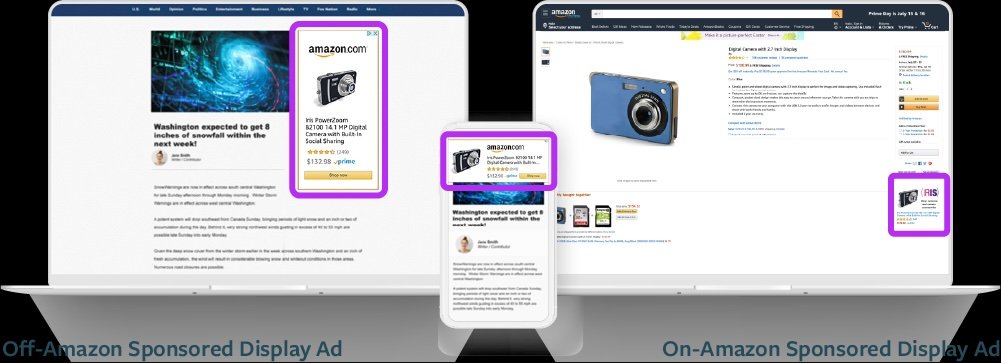Part 3: Mastering Sponsored Display Ads - Best Practices and Offensive & Defensive Product Targeting Strategies
#3 in BirdDog’s Retail Media Principles 4-Part Series
By Jeff Coleman, Chief Client Officer at BirdDog
In the dynamic world of retail media, Sponsored Display ads have become a vital tool for brands to engage shoppers throughout the buying journey. Unlike other ad types, Sponsored Display ads allow advertisers to target audiences both on and off the retailer’s platform, creating opportunities for expanded reach and precise targeting.
This blog post explores best practices for Sponsored Display campaigns and dives into offensive and defensive product targeting strategies to help brands maximize their return on investment (ROI). Backed by actionable insights and key data points, this guide is your roadmap to retail media success.
Understanding Sponsored Display Ads
Sponsored Display ads are versatile, allowing advertisers to:
Re-engage shoppers: Target those who viewed your product but didn’t convert.
Target competitor audiences: Appear alongside competing products.
Expand visibility: Reach audiences based on interests and browsing behavior.
Key Data Point: According to Amazon Advertising, advertisers who use Sponsored Display in conjunction with Sponsored Products and Sponsored Brands see an average 20% increase in total campaign performance.
Sponsored Display Best Practices
1. Define Clear Objectives
Establish clear goals for your Sponsored Display campaigns, such as:
Driving product awareness.
Boosting sales for specific SKUs.
Protecting market share from competitors.
Align your ad creatives and targeting options with these objectives.
2. Leverage Audience Targeting
Sponsored Display offers two primary targeting options:
Views Remarketing: Re-engage shoppers who have viewed your product or similar items.
Interest-Based Targeting: Reach audiences based on their shopping interests.
Pro Tip: Use views remarketing for high-consideration products and interest targeting for brand discovery campaigns.
3. Optimize Ad Creatives
Sponsored Display ads appear across various placements, including product detail pages and off-site locations. To maximize impact:
Use high-quality images.
Write concise, benefit-driven copy.
Highlight unique selling points (USPs).
Data Point: A study by eMarketer found that ads with clear CTAs and visually appealing images achieved 30% higher click-through rates (CTR).
4. Monitor and Adjust Bids
Set competitive bids for high-visibility placements and adjust based on performance. Sponsored Display’s dynamic bidding automatically increases or decreases bids based on likelihood of conversion, making it an essential tool for maximizing ROI.
5. Test and Learn
Run A/B tests to compare creatives, targeting options, and bidding strategies. Continuously analyze performance metrics to refine your campaigns.
Offensive Product Targeting Strategies
Offensive targeting involves capturing market share by targeting competitors’ audiences or categories. Here’s how to implement effective offensive strategies:
1. Target Competitor ASINs
Position your product as an alternative to competitors by targeting their ASINs (Amazon Standard Identification Numbers). This strategy works best for:
Products with superior features or pricing.
Categories where brand loyalty is low.
Example: A mid-range electronics brand targets premium competitors, highlighting affordability and similar specifications.
Data Point: According to Jungle Scout, 41% of shoppers compare at least two products before making a purchase, making ASIN targeting crucial.
2. Leverage Category Targeting
Target entire product categories to broaden reach. Refine this approach by:
Focusing on subcategories relevant to your product.
Excluding unrelated categories to optimize spend.
3. Promote Complementary Products
Appeal to shoppers buying related products by targeting complementary ASINs. For example, a laptop brand could target mouse or laptop bag listings.
Pro Tip: Include a discount or bundle offer to enhance appeal.
Defensive Product Targeting Strategies
Defensive targeting aims to protect your brand’s market share by ensuring competitors don’t divert your customers. Here’s how to implement defensive strategies effectively:
1. Target Your Own ASINs
Prevent competitors from capturing your customers by targeting your own product listings. This approach:
Encourages cross-selling.
Reduces the likelihood of shoppers clicking away to a competitor.
Example: A skincare brand promotes related products (e.g., moisturizers and cleansers) on its own product pages.
Data Point: Brands that target their own ASINs see a 15% increase in cross-sell opportunities, according to an Amazon case study.
2. Bid Aggressively on High-Traffic Products
Identify your best-performing products and allocate higher bids to protect their placements. Use historical data to pinpoint SKUs with:
High conversion rates.
Frequent competitor encroachment.
3. Focus on Brand Loyalty
Reinforce your brand’s value proposition by highlighting loyalty programs, customer reviews, and exclusive offers within your ads. Defensive targeting paired with strong branding can significantly reduce customer churn.
Measuring Success
Track these key performance indicators (KPIs) to evaluate your Sponsored Display campaigns:
Impressions: Measure the reach of your ads.
CTR: Assess how well your creatives attract clicks.
Conversion Rate: Determine how effectively clicks translate into sales.
ROAS: Calculate the profitability of your campaigns.
Data Point: Campaigns using both offensive and defensive targeting strategies achieve an average ROAS of 4:1, per a recent Feedvisor report.
Case Studies: Sponsored Display in Action
Offensive Targeting Success
A mid-tier home appliance brand used ASIN targeting to promote its products against premium competitors. By emphasizing energy efficiency and affordability, the brand:
Increased CTR by 25%.
Achieved a 20% higher conversion rate compared to non-targeted campaigns.
Defensive Targeting Success
A cosmetics brand focused on defending its best-selling foundation by targeting its own ASIN. This strategy:
Reduced competitor clicks by 30%.
Boosted cross-sell revenue by 18% through additional product promotions.
Conclusion
Sponsored Display ads offer powerful tools for brands to expand reach, defend market share, and drive conversions. By combining best practices with offensive and defensive targeting strategies, you can create campaigns that deliver measurable results.
As retail media continues to grow, mastering these strategies will be essential for staying competitive. Start optimizing your Sponsored Display campaigns today and unlock new opportunities for growth.


